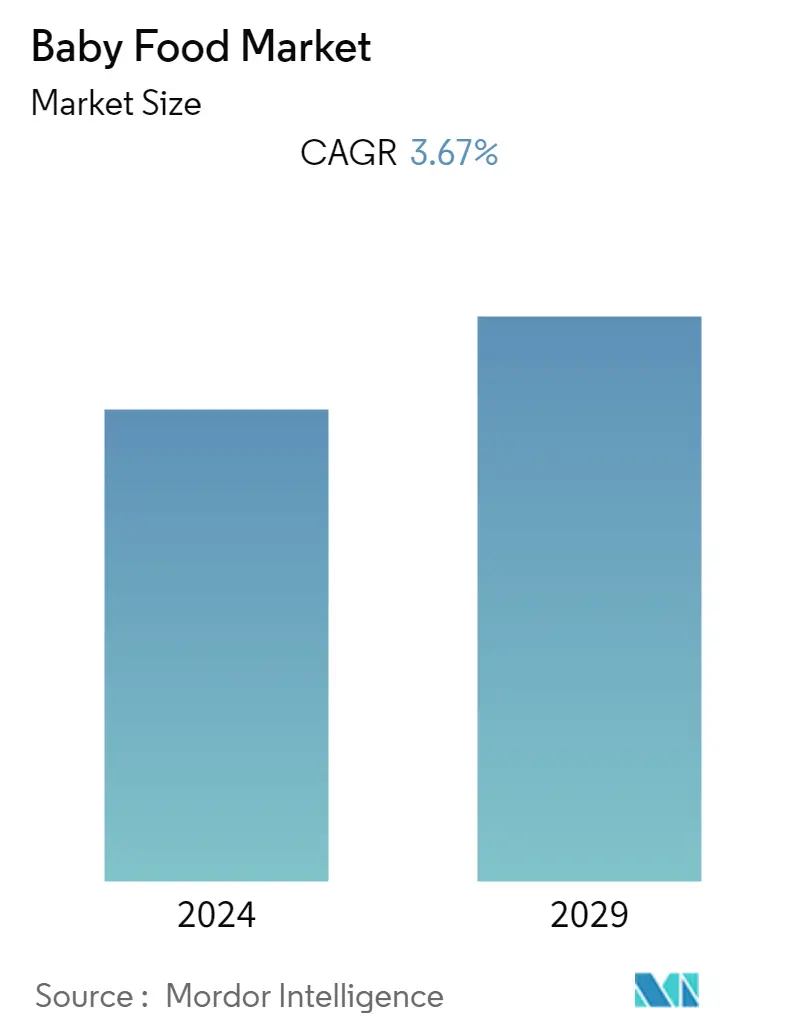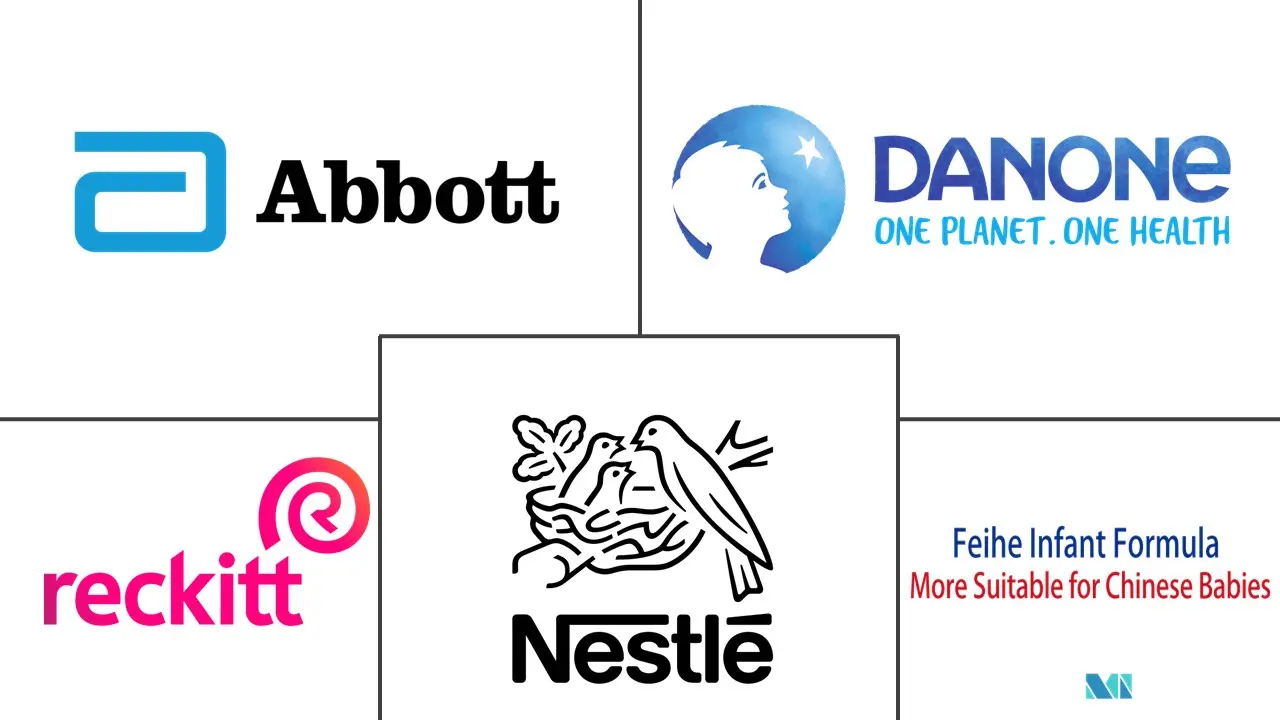Market Size of Baby Food Industry

| Study Period | 2019 - 2029 |
| Base Year For Estimation | 2023 |
| CAGR | 3.67 % |
| Fastest Growing Market | Asia Pacific |
| Largest Market | Asia Pacific |
| Market Concentration | Medium |
Major Players
*Disclaimer: Major Players sorted in no particular order |
Baby Food Market Analysis
The baby food market is projected to register a CAGR of 3.67% during the forecast period.
The increasing working female population and rising disposable income are also aiding the market growth for baby food. The rising infant population and awareness about baby food products and their nutritional values further boost the baby food product demand. Moreover, because of the existing malnutrition and hunger issues facing infants in many developing and underdeveloped countries, the market for baby food is also set to grow in the future.
According to the United Nations International Children's Security Fund (UNICEF), malnutrition contributes to half of all deaths among children under five worldwide. The market expects growth amid innovations with key ingredients, such as human milk oligosaccharides (HMOs) and probiotics. Recently, there is an increase in the demand for organic baby food. It can be attributed to the number of women working increased. These convenient foods are in great demand, resulting in growth in the market due to the increased demand for them.
As a result of limited time for housekeeping, modern households are increasingly using these convenient and nutritious packaged baby foods. Over the long term, manufacturers are developing products that support the immune system from infancy. Key players in the market are constantly launching new products to make them more appealing to parents and infants, aiding the market's growth. For instance, in July 2022, UK-based Organix launched two new organic baby and toddler food ranges: Baby Meals and Organix Kids. They are available through Asda and its online store.
Baby Food Industry Segmentation
Baby food is any soft, easily digestible meal created particularly for human babies aged 4-6 to two years old. The baby food market is segmented by category, type, distribution channel, and geography. By category, the market is segmented into organic and conventional. By type, the market is segmented into milk formula, dried baby food, ready-to-feed baby food, and other types. By distribution channel, the market is segmented into drugstores/pharmacies, supermarkets/hypermarkets, convenience stores, online channels, and other distribution channels. The study analyzes the baby food market in emerging and established markets worldwide, including North America, Europe, Asia-Pacific, South America, and Middle-East & Africa. The market sizing and forecast for each segment are based on value (USD billion).
| By Category | |
| Organic | |
| Conventional |
| By Type | |
| Milk Formula | |
| Dried Baby Food | |
| Ready to Feed Baby Food | |
| Other Types |
| By Distribution Channel | |
| Drugstores/ Pharmacies | |
| Supermarkets/ Hypermarkets | |
| Convenience Stores | |
| Online Channels | |
| Other Distribution Channels |
| By Geography | |||||||||
| |||||||||
| |||||||||
| |||||||||
| |||||||||
|
Baby Food Market Size Summary
The baby food market is experiencing steady growth, driven by factors such as the increasing number of working women and rising disposable incomes. This trend is further supported by a growing awareness of the nutritional benefits of baby food products. The demand for baby food is also bolstered by the need to address malnutrition and hunger issues in developing regions. Innovations in baby food, including the incorporation of human milk oligosaccharides and probiotics, are expected to enhance market growth. The shift towards organic baby food is notable, as more parents, particularly working mothers, seek convenient and nutritious options that fit their busy lifestyles. This has led to a rise in the popularity of ready-to-eat and packaged baby foods, which are favored for their convenience and time-saving benefits.
The Asia-Pacific region holds a significant share of the global baby food market, with China leading the charge. The region's growth is attributed to its expanding population, busy lifestyles, and increasing consumer spending. Developing countries like India and Indonesia are also contributing to this growth, driven by modern retail expansion and rising purchasing power. The market is becoming increasingly competitive, with major players like Nestlé, Danone, and Abbott Laboratories actively engaging in product launches and strategic partnerships to strengthen their market presence. The trend towards vegan-based baby foods is gaining traction, with manufacturers introducing plant-based products to cater to this growing consumer segment. Overall, the baby food market is poised for continued expansion, supported by evolving consumer preferences and innovative product offerings.
Baby Food Market Size - Table of Contents
-
1. MARKET DYNAMICS
-
1.1 Market Drivers
-
1.2 Market Restraints
-
1.3 Porter's Five Forces Analysis
-
1.3.1 Bargaining Power of Suppliers
-
1.3.2 Bargaining Power of Buyers/Consumers
-
1.3.3 Threat of New Entrants
-
1.3.4 Threat of Substitute Products
-
1.3.5 Intensity of Competitive Rivalry
-
-
-
2. MARKET SEGMENTATION
-
2.1 By Category
-
2.1.1 Organic
-
2.1.2 Conventional
-
-
2.2 By Type
-
2.2.1 Milk Formula
-
2.2.2 Dried Baby Food
-
2.2.3 Ready to Feed Baby Food
-
2.2.4 Other Types
-
-
2.3 By Distribution Channel
-
2.3.1 Drugstores/ Pharmacies
-
2.3.2 Supermarkets/ Hypermarkets
-
2.3.3 Convenience Stores
-
2.3.4 Online Channels
-
2.3.5 Other Distribution Channels
-
-
2.4 By Geography
-
2.4.1 North America
-
2.4.1.1 United States
-
2.4.1.2 Canada
-
2.4.1.3 Mexico
-
2.4.1.4 Rest of North America
-
-
2.4.2 Europe
-
2.4.2.1 United Kingdom
-
2.4.2.2 Germany
-
2.4.2.3 Spain
-
2.4.2.4 France
-
2.4.2.5 Italy
-
2.4.2.6 Russia
-
2.4.2.7 Rest of Europe
-
-
2.4.3 Asia-Pacific
-
2.4.3.1 China
-
2.4.3.2 Japan
-
2.4.3.3 India
-
2.4.3.4 Australia
-
2.4.3.5 Rest of Asia-Pacific
-
-
2.4.4 South America
-
2.4.4.1 Brazil
-
2.4.4.2 Argentina
-
2.4.4.3 Rest of South America
-
-
2.4.5 Middle-East and Africa
-
2.4.5.1 South Africa
-
2.4.5.2 Saudi Arabia
-
2.4.5.3 Rest of Middle-East and Africa
-
-
-
Baby Food Market Size FAQs
What is the current Baby Food Market size?
The Baby Food Market is projected to register a CAGR of 3.67% during the forecast period (2024-2029)
Who are the key players in Baby Food Market?
Nestlé SA, Danone SA, Reckitt Benckiser Group PLC, Abbott Laboratories and Feihe International Inc. are the major companies operating in the Baby Food Market.

